When choosing the components which shape their sound and playing style, guitarists often focus on strings and pickups. Guitar bridges are commonly overlooked, but in reality, they are equally as important as the aforementioned parts.
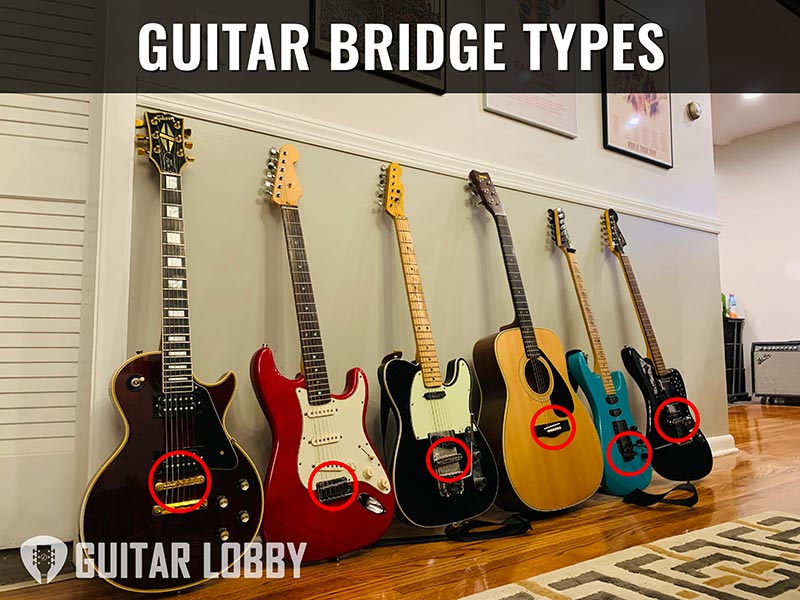
Whether you’d like to produce immersive tremolo effects or use distinctive techniques like dive bombs, choosing the right bridge for your guitar is essential. In this definitive guide, we’ll take a look at each of the bridge types for acoustic and electric guitars, before explaining why they are such an integral component and how you can use them most effectively.
Table of Contents
Guitar Bridge Types
Fixed Bridges for Electric Guitar
Fixed bridges are attached to the body of an electric guitar, hence their name. They are solidly connected to the instrument, which prevents them from moving. This enhances tuning stability, but it also prevents the bridge from producing vibrato.
1. Tune-O-Matic Bridges
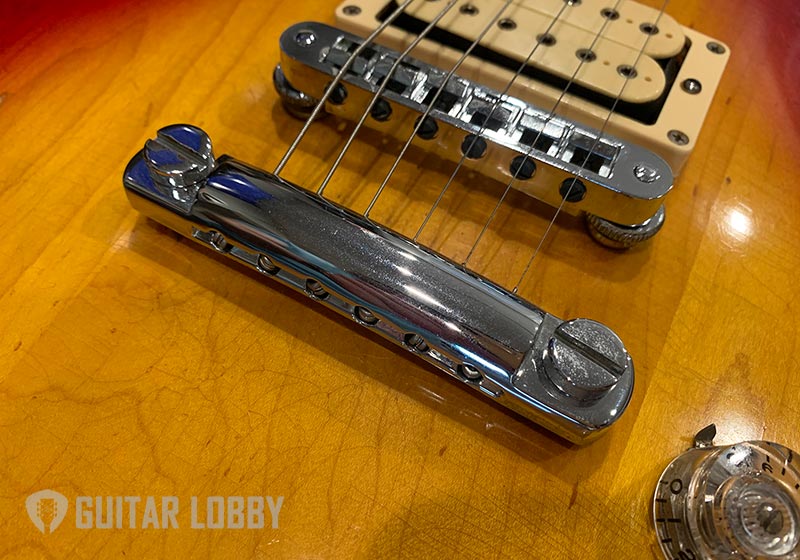
The Tune-O-Match bridge was first introduced by guitar heavyweights Gibson in the early 1950s when they used it on their classic 1952 Les Paul Custom. This fixed bridge was designed to enhance the precision of the adjustments which could be made to the intonation of the strings.
Secured using two screw mounts which are located on either side, tune-o-matic bridges allow the guitarist to tailor the action of their strings by tightening or loosening the screws. Each string has its saddle which can also be adjusted using the tiny screws at the back of the bridge.
Unlike hardtail and wrap-around bridges, tune-o-matics have a separate saddle and tailpiece. This means that an extra tailpiece must be used with the bridge to hold them in place, which may sound inconvenient but in reality, it forms a very strong connection and is easy to connect.
Pros:
The main advantage that tune-o-matic bridges have over the other fixed bridge types is that they allow you to be incredibly accurate with your intonation. They’re also incredibly easy to use, and make restringing your guitar a breeze. Additionally, they can easily be changed into a tremolo bridge, which I’ll discuss in detail in a later section.
Cons:
Despite their undeniable benefits, tune-o-matic bridges do have a couple of downsides. Firstly, they are only capable of adjusting the height of the guitar’s strings all at once, which is in contrast to their ability to intonate each string separately. Also, they are most compatible with guitar’s which have a fretboard radius of 12 inches or below.
The Best Tune-O-Matic Bridges:
High-end bridge designers, Gotoh, offer two exceptional tune-o-matic bridges. The Tune-O-Matic Bridge with Studs/Bushings is a great choice for those who play a traditional solid-body guitar, and their Gold Tune-O-Matic is another brilliant offering.
An undeniable advantage of using a hardtail bridge is that it makes re-stringing and adjusting intonation very easy. Most of these bridges allow you to feed the strings through the rear of the guitar so that the ends are secured by the solid metal plate of the bridge.
Hard-tails also commonly feature individual saddles for each guitar string. These saddles can be easily moved using a screwdriver, which raises or lowers the action of the string and consequently adjusts the intonation.
Pros:
Hardtail bridges are very robust, due to them being a singular unit. They are attached to the body of the guitar using solid metal screws, which prevents the bridge from moving and therefore promotes tuning stability and intonation. They also make installing new strings a very simple process.
Cons:
One disadvantage of using hardtail bridges is that there’s no chance of producing any tremolo because they can’t move at all. They’re also pretty difficult to customize if you wanted to produce tremolo effects, due to the way they are attached to the guitar’s body.
The Best Hardtail Bridges:
Gotoh’s Hardtail Bridge is one of the best on the market and is compatible with most Strat-style guitars which feature through-body string mounting. Fender’s 6-Saddle Hardtail Bridge is another brilliant option and can be used on a variety of their iconic electric guitars.
2. Wrap-Around Bridges
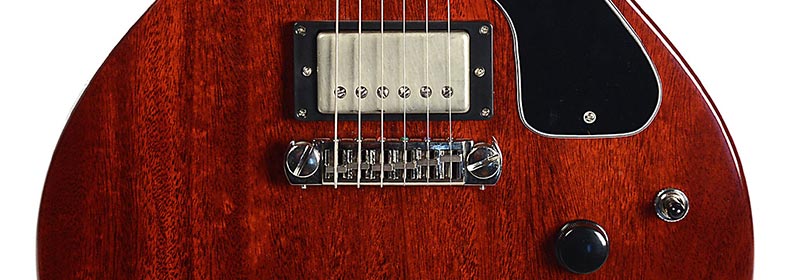
Wrap-around bridges are the longest-standing type of electric guitar bridge. Their longevity is a strong indicator of the qualities these bridges offer, and if you look at the history of most major guitar manufacturers you’ll likely find that they’ve used a wrap-around sometime in the past.
The name of these bridges comes from the way that the strings slot through their front section, after which they are wrapped around the tailpiece, nestling on the saddle. These devices are designed so that the saddle and bridge are combined into one unit, increasing the solidity.
Vintage wraparounds were plagued by issues surrounding intonation and tuning stability, due to their design. However, they have gradually improved as time has passed, and these days each saddle can be adjusted to rectify any intonation problems.
Pros:
Of all the fixed bridge varieties, wrap-around is by far the easiest for restringing a guitar. This is because the strings are simply fed into the underside of the bridge, and wrapped around its upper section. For this reason, wrap-around bridges are a great choice for beginners who aren’t very confident at restringing their instruments.
Cons:
One of the main issues with this bridge type is their inability to achieve accurate intonation. As I explained earlier, this problem has improved over time, but wrap-around bridges still lack the pinpoint accuracy of other bridge types. It’s also very difficult to convert this bridge to a tremolo device, for the same reasons as with hardtail bridges.
The Best Wrap-Around Bridges:
Two of the best wrap-around bridges are the Gotoh 510UB and the Golden Age Adjustable Wraparound Bridge. The former features a stylish black design, hardened saddles made from zinc, and a secure stud-lock mechanism. The latter is also highly robust, and both have individual saddles for each string.
3. Hardtail Bridges
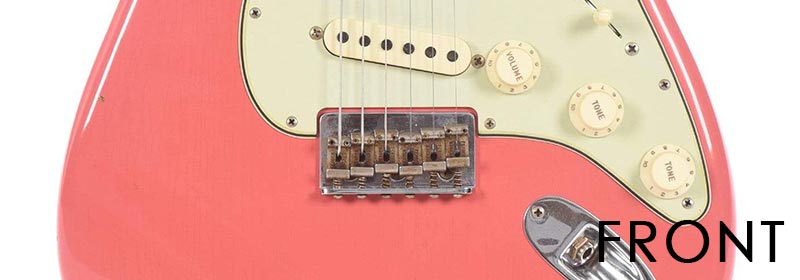

Hardtail bridges, also called ‘hard-tails’, feature a singular unit that is directly attached to the body of the electric guitar. It is solidly mounted onto the body using a pair of robust metal screws. This ensures that the bridge doesn’t move at all.
Tremolo/Floating Bridge Types for Electric Guitar
Tremolo/floating bridges are an alternative to fixed bridges. This variety allows the guitarist to produce a blend of tremolo and fluttering effects due to their flexibility, which is a popular tool used by lead guitarists to color their riffs, solos, and melodies. Within the categories of fixed and tremolo/floating guitar bridges, you’ll find plenty of variation. It’s, therefore, necessary for us to dissect each type thoroughly so that you understand the impact they have on the way a guitar sounds and plays.
4. Synchronized Tremolo Bridges
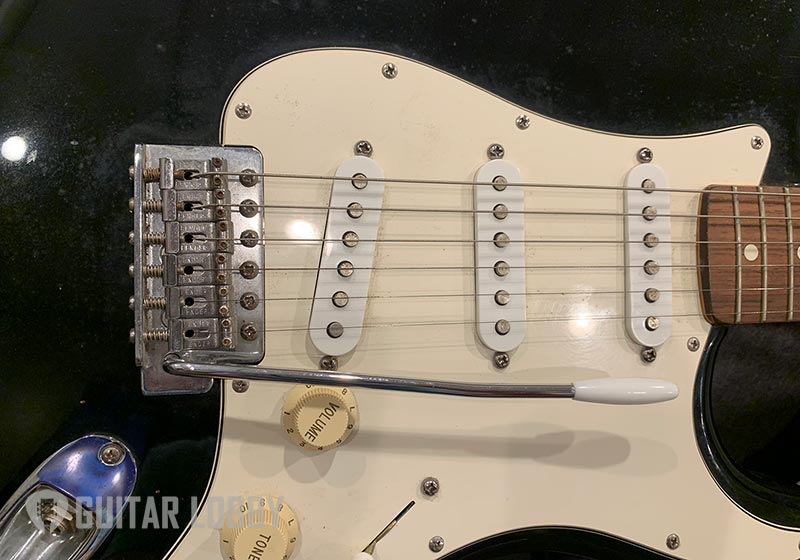
A synchronized tremolo bridge is found on many Fender guitars, due to its ability to control the motion of the tailpiece and the bridge of the instrument. With this type of floating bridge, the strings extend through the block, stretching over the guitar. The tailpiece block is secured at the correct angle by a series of springs.
The main advantage of a synchronized tremolo bridge, which explains why Fender likes to use them on some of their electric guitars, is because the tailpiece is connected to the bridge in a singular unit. There is an upper plate that is made from metal, and the edge is slightly angled so that it can rest against the guitar’s body.
This design allows the whammy bar to be used to its fullest capacity, as when the bar is depressed, the entire bridge and tailpiece move simultaneously, causing the string’s tension to be altered and therefore modulating the pitch momentarily. Another thing worth noting about synchronized tremolo bridges is that they include individual saddles for each string.
Pros:
Fender’s synchronized tremolo bridge design promotes accurate intonation and tuning of the guitar’s strings because it allows the tailpiece and the bridge to move together. Another benefit of this bridge type is that it allows guitarists to achieve substantial pitch shifts when engaging their whammy bar, making it a great choice for solos and lead parts.
Cons:
Unfortunately, there’s one key downside to synchronized tremolo bridges – they’re incapable of producing dive bombs. In fact, due to their design, attempting this would likely damage the bridge!
The Best Synchronized Tremolo Bridges:
Fender produces several brilliant synchronized tremolo bridges, including this one specifically for their Standard Series Stratocaster. Additionally, the Super-Vee Blade Runner Tremolo is another example of a high-end synchronized bridge that is very popular amongst solid body guitarists.
5. Floyd Rose Tremolo Bridge
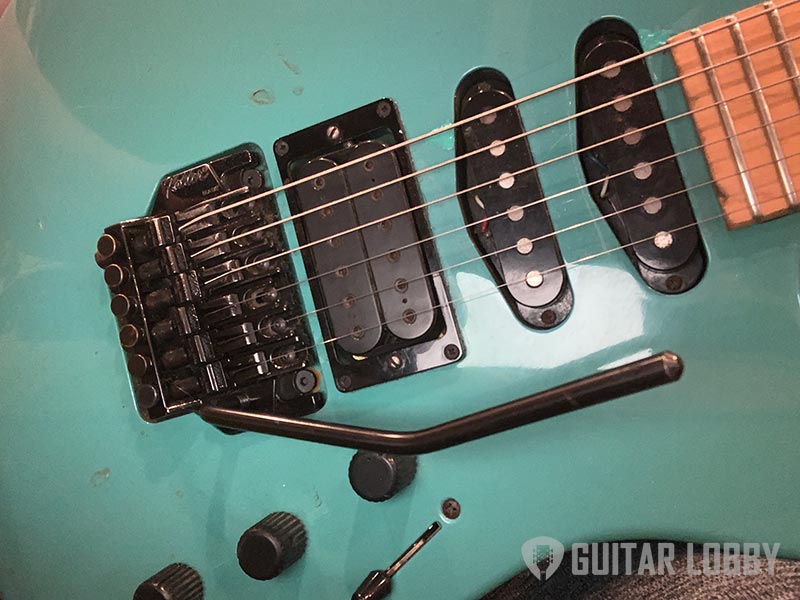
Floyd Rose tremolo bridges are a popular choice on high-end electric guitars. Renowned for their impeccable ability to produce tremolo-based effects such as dive bombs, these bridges are essentially a slightly varied version of a standard tremolo bridge.
To change the tension of the strings on an electric guitar, Floyd Rose tremolo bridges utilize the springs which are installed within the instrument’s body. They interact with these springs using a pivot mechanism.
Floyd Rose bridges use locking nuts, rather than the traditional nuts found in most other tremolo bridges. This allows them to clamp the strings in place, neutralizing the motions which commonly cause the tuning to be adversely affected. The strings are held in the correct position at the guitar’s headstock, thanks to the security of the locking nut mechanism.
Pros:
The biggest advantage of Floyd Rose bridges is that they allow the guitarist to easily perform the dive-bomb technique, because of the springs which are built into them. These springs allow the bridge to sway. Another advantage is that their locking nuts help the guitar to stay in tune.
Cons:
Floyd Rose tremolo bridges are considered to be one of the most complex systems, which makes them difficult to set up, adjust, or customize. This also makes changing strings more difficult compared to the other guitar bridge types.
The Best Floyd Rose Bridges:
When it comes to Floyd Rose bridges, the Special Series provides the pinnacle of quality and performance. This bridge includes an R2 nut for ultra stability and uses zinc to allow for both the saddle and the tremolo block.
6. Bigsby Tremolo Bridges
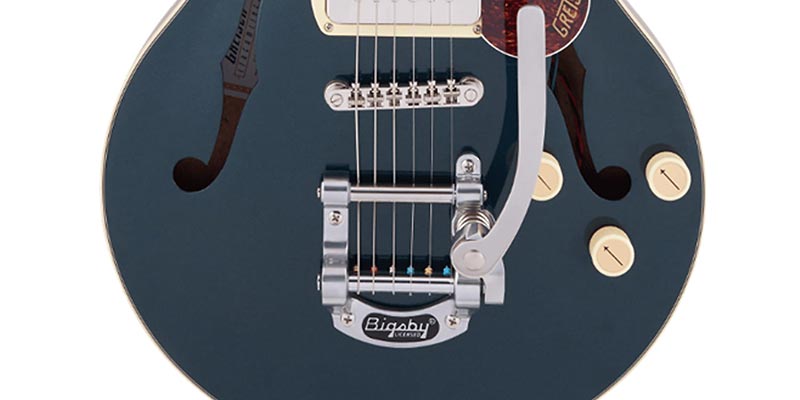
Designed by Paul Bigsby over seventy years ago, the Bigsby bridge marked a revolutionary discovery for electric guitarists. Its production is now overseen by Fender, who owns the company that is responsible for designing these unique tremolo bridges.
It’s unlikely, however, that you’ll ever see a Bigsby installed on a popular Fender solid-body like the Tele or Strat. They’re best suited to semi-hollow or hollow body axes and are also compatible with Les Paul’s archtop body type. The key sonic impact that a Bigsby bridge has on a guitar is the way it modifies the tone, by shortening and lengthening the strings of the instrument.
Design-wise, the Bigsby tremolo bridge includes a pair of bars with an arm that has a spring connected to it. These two components are integral to its functioning, as the first bar maintains the string’s tension, and the second one is malleable so that it can sway with the arm’s movements.
The guitarist is then able to depress the tremolo arm in the direction of the guitar’s upper side, which causes the strings to lose tension momentarily. This creates notes of a lower pitch, producing the fluttering vibrato effect which is so highly sought after by lead guitarists. To reverse the process and create notes of a higher pitch, the guitarist instead lifts the arm upwards, and the Bigsby works its magic.
Pros:
The Bigsby bridge is a great tool for creating a slight vibrato that colors the sound of a guitar. It sounds smooth and understated and doesn’t detract from the overall tone too dramatically. Another undeniable benefit of a Bigsby bridge is its distinguished, vintage appearance.
Cons:
Unfortunately, the design of a Bigsby bridge makes it susceptible to tuning issues. It’s also quite difficult to change the strings on a guitar when using this type of bridge, so inexperienced guitarists may prefer to use a more simple variety.
The Best Bigsby Tremolo Bridges:
There are many high-quality Bigsby tremolo bridges available, but one that stands out is the Mosby Tremolo and Bridge Assembly. It includes a tune-o-matic roller bridge for ultimate tuning stability, but also offers all of the benefits of the Bigsby vibrato add-on.
7. Stetsbar Tremolo Bridges
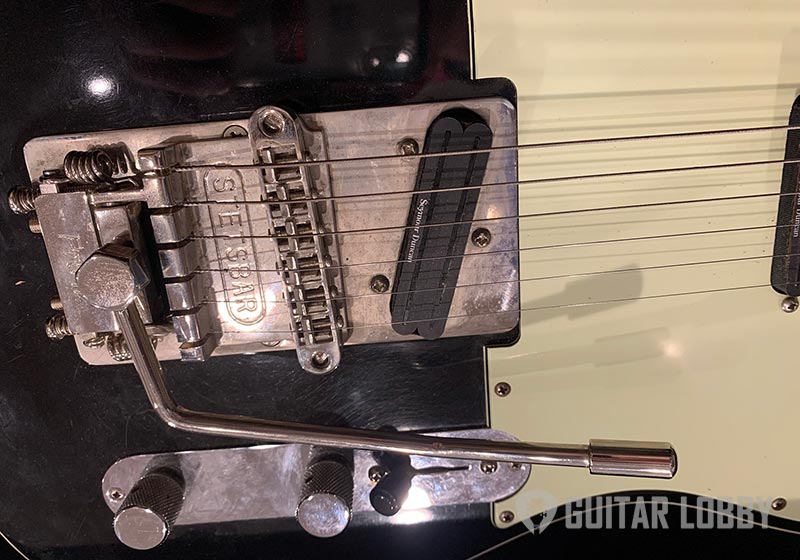
The final variety of tremolo bridges is known as the Stetsbar. Also sometimes called a ‘tremolo roller bridge’, this system is designed to switch a standard tune-o-matic from a fixed bridge to a tremolo bridge so that vibrato can be created.
As I’ve explained, some fixed bridges are very difficult to switch to a tremolo system, and doing so can leave your guitar permanently modified. However, by using a Stetsbar, guitarists can switch their tune-o-matic bridge without needing to change anything about their guitar permanently.
The most common users of Stetsbar bridges are guitarists who play Les Paul’s. They’re designed specifically for Les Paul-type guitars, and it makes switching the bridge system from fixed to tremolo a very simple process.
Pros:
Stetsbar tremolo bridges have one notable benefit – they allow you to convert your fixed tune-o-matic bridge into a floating tremolo system. This means that you can enjoy the benefits of the tune-o-matic, such as tuning stability and precise intonation, while also being able to add vibrato manually.
Cons:
The size of the metal hardware. A Stetsbar mounting plate will cover much of the top of your guitar around and between the bridge and tail.
Acoustic Guitar Bridge Types
The bridge of an acoustic guitar is responsible for two main important functions. First of all, the bridge saddle determines the action of the acoustic guitar strings, which simply means the distance between the strings and the fretboard.
The higher the activity of the acoustic guitar, the more force is generally required to push the strings down to the frets to play different notes. However, if the action is too low, this may lead to the strings resting on frets that aren’t intended to be used, causing unwanted sounds or frequencies.
The second role of the bridge on an acoustic guitar is to transmit the vibration from the strings to the soundboard, which adds to the overall resonance of the instrument.
8. Fixed Acoustic Guitar Bridges
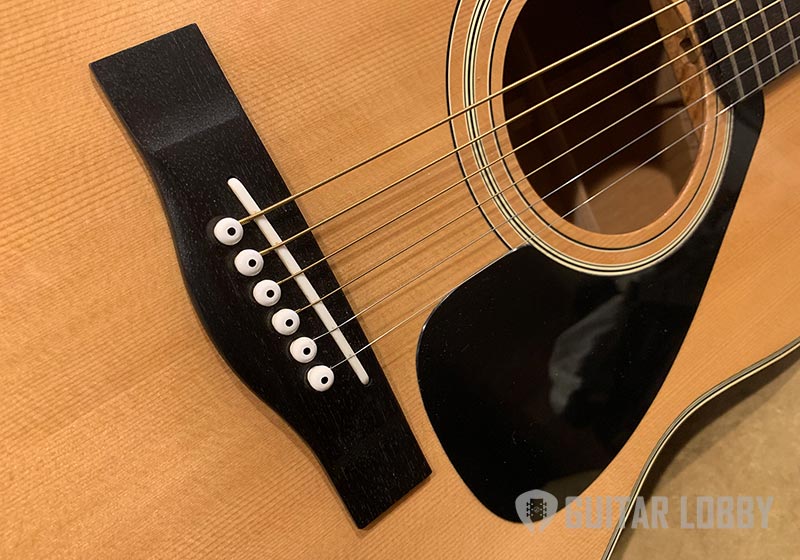
The vast majority of acoustic guitars use a fixed bridge. Similar to electric guitars, fixed bridges are directly attached to the body of the instrument, most commonly with a strong glue. The strings are then hooked up to a set of pegs, which are then inserted into specifically designed holes and pushed into place.
Fixed acoustic guitar bridges are regarded as the most robust and sturdy variety because there’s no way they can move out of place due to their secure attachment to the guitar’s body. They, therefore, tend to hold tuning very well.
9. Floating Acoustic Guitar Bridges
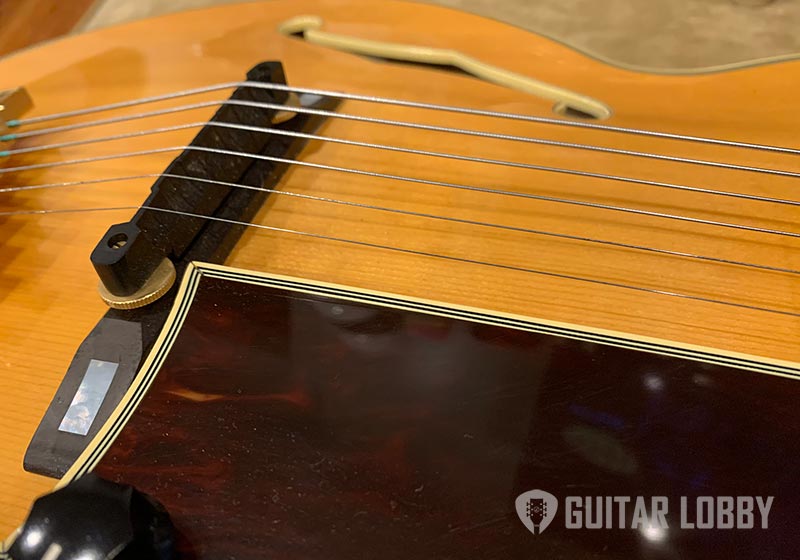
Floating acoustic guitar bridges are significantly different from fixed varieties because rather than the strings being attached to the body via a set of pegs, they are attached to a fixed tailpiece. The intonation can then be changed by adjusting the position of the jumper that the strings reside on.
In contrast to floating bridges for electric guitars, those made specifically for acoustic guitars aren’t generally designed for the purpose of producing vibrato. They do however offer the guitarist more flexibility when tweaking the pitch of their instrument compared to fixed bridges.
10. Grooved Fixed Bridge
Some rare guitar models use a variation of the fixed bridge, which is known as the ‘grooved fixed bridge’. This variety differs from the traditional fixed guitar bridge in that rather than the strings being fed into the holes and held there by a set of pegs, they are fed horizontally into the bridge. They are then secured by placing small balls into the appropriate positions.
The name comes from the fact that there is a groove situated on the bridge, which extends above it. Inside that groove, the bridge bone resides. This allows the acoustic guitar strings to vibrate from a slightly different position than they would when using a conventional fixed bridge.
Materials
As is the case with the other parts of an acoustic guitar, the material used to make the bridge is most commonly a variety of wood. This is in stark contrast to the bridges found on electric guitars, which are made from metal material in almost all cases.
Just as the tonewoods used to construct the body, neck, and fretboard of an acoustic guitar are very important, the type of wood used for the bridge also impacts the sound and performance of the instrument. This is because the bridge is responsible for transmitting vibrations to the guitar’s body. The goal when choosing the material of the bridge is to select a wood that enhances this process as much as possible.
It’s therefore most common for acoustic guitar manufacturers to use dense varieties of woods to construct the bridge. They also tend to be relatively lightweight, to avoid making the instrument unnecessarily heavy, which could impact playing comfort.
Indeed, there’s also the aesthetical aspect that must be considered. Acoustic guitars are beautiful instruments, and many musicians consider appearance as equally as the sonic qualities when choosing their particular brand and model.
Most decent acoustic guitars come with a bridge that is made from high-quality tonewood, such as rosewood, ebony, or in some rare cases, maple. These wood types are known for their stylish looks, ability to promote resonance, and their longevity.
Everything You Need to Know About Acoustic & Electric Guitar Bridges
Summary of Electric Guitar Bridge Types
Fixed Guitar Bridges:
1. Tune-O-Matic Bridge
2. Wrap-Around Bridge
3. Hardtail Bridge
Tremolo/Floating Guitar Bridges:
4. Synchronized Tremolo Bridge
5. Floyd Rose Tremolo Bridge
6. Bigsby Tremolo Bridge
7. Stetsbar Tremolo Bridge
Summary of Acoustic Guitar Bridge Types
8. Fixed Acoustic Bridge
9. Floating Acoustic Bridge
10. Grooved Fixed Acoustic Bridge
Electric Guitar Bridge Types – Fixed vs. Tremolo/Floating
Compared to acoustic guitars, there are significantly more bridge types available for electric guitars. Some of these bridges are exclusive to specific electric guitar types, while others are compatible with a wider range.
Electric guitar bridges are split into two categories – fixed, and tremolo. Tremolo bridges are also sometimes called floating bridges. I’ll explain the differences between the two shortly, but for now, you can find a breakdown of individual bridges in each category below.
Guitar bridges impact the sound of the instrument, its ability to stay in tune, and how easy it is to change strings. The importance of this component shouldn’t be overlooked, and it’s a subject that every guitarist should study to improve their understanding of how their instrument works.
After reading the above sections, you should now have a good general overview of the main electric guitar bridge types. In the remainder of this guide, I’ll provide more insights on acoustic guitar bridges, in addition to further information on electric guitar bridges.
Classical Guitar Bridges
Classical guitars use nylon strings, which gives them their distinctive sound. The bridges used for these elegant instruments are almost identical to the standard fixed bridges used for acoustic guitars, however, there is one key difference.
It’s most likely that the bridge on a classical guitar will be made from mahogany, which is considered to be the gold standard for this purpose. There’s then a specially designed saddle which is made from composite materials.
The nylon strings are fed through individual holes in the bridge and then wrapped back around themselves to form a secure connection. This is a departure from the way that the strings are attached to the bridge of an acoustic guitar, with no pins required to create adequate tension on each string.
Acoustic Guitar Saddles
The saddle is an essential part of the acoustic guitar’s bridge system. It impacts the tone of the instrument, its intonation, and its action. However, there is another key aspect of the saddle that is often overlooked.
As I previously explained, the acoustic guitar bridge is responsible for transmitting the string’s vibrations to the body of the guitar. The saddle aids the bridge in carrying out this process.
Acoustic guitar saddles need to be made from a hard, dense material to minimize the vibrational energy that is lost after the strings are played. Consequently, they’re often made from bone. Cheaper alternatives include plastics and other synthetic materials such as TUSQ.
Bone and ivory are considered to be the best materials for acoustic guitar saddles, and you can expect to find them on high-end models made by manufacturers such as Martin, Taylor, or Fender. They’re also more expensive, and some ethical concerns are surrounding the sourcing of these materials.
Acoustic Guitar Bridge Pins
Along with the saddle and the bridge itself, another key component is the bridge pins. Used to secure the ball ends of the strings to the bridge plate of the guitar, bridge pins are vital when installing new strings on the instrument.
They also impact the sound of an acoustic guitar to an extent, because the vibrations from the strings are carried into the body through the pins. The two main varieties of bridge pins are known as ‘slotted’ and ‘unslotted’ – the most common type being the latter.
Unslotted pins don’t contain a cut-out groove and are intended to be used with a slotted bridge. Slotted pins, on the other hand, have a small groove cut out of them so that the string can be secured in an unslotted bridge.
Here’s a breakdown of the main materials used to construct bridge pins for acoustic guitars, and how they impact tone.
Plastic
Plastic bridge pins are the most common type, for several reasons. Firstly, they’re cost-effective and very easy to make, so manufacturers can mass-produce them for installation in their acoustic guitar ranges. Another advantage of plastic is that it won’t break due to exposure to different temperatures when in transit.
Nevertheless, plastic bridge pins do have some disadvantages. Notably, they tend to warp and become worn out quite quickly, due to their relative softness. They have very little impact on an acoustic guitar’s tone, and some may consider them to look a little tacky compared to other materials.
Ivory
Another material commonly used to make bridge pins is ivory. Known for its elegant appearance, ivory is a very expensive material that you’ll likely only find on the very highest-end acoustic guitars. Along with its beautiful aesthetics, this material is known to enhance the warmth of an acoustic guitar’s tone.
As I touched upon in an earlier section, many ethical problems are surrounding the use of ivory for bridge pins, or any part of an acoustic guitar for that matter. It’s therefore advisable to steer clear of ivory and opt for a more sustainable, cruelty-free type of bridge pin.
Wood
Thirdly, we have trusty wood. Much of the appearance of an acoustic guitar comes down to the combinations of woods that are used to construct the various parts, so using quality tonewood for the bridge pins seems like a no-brainer. Unfortunately, despite its tonal and aesthetical benefits, there is one key issue with this.
Wood reacts to temperature changes and moisture in the air more than any other bridge pin material. It tends to swell and expand, which isn’t ideal for bridge pins, and in some cases, it can cause damage to the acoustic guitar’s bridge.
Bone
Bone bridge pins are also featured on many high-end acoustic guitar models. This material enhances both the brightness and the sustain of the guitar and also helps to produce a more well-rounded, full-sounding tone.
Another benefit of using bone bridge pins is that this material is highly durable, and isn’t affected by changes in temperature. It’s slightly more expensive than plastic, but generally looks more distinguished and will last for much longer.
Brass
Out of all of the mentioned options for bone pin materials, when it comes to durability there’s one clear winner –brass. This material is an acquired taste, as it tends to enhance the treble of the guitar and increase its brightness.
Therefore, an acoustic guitar that sounds a little too heavy in the low-end may benefit from having brass bridge pins installed. They’re quite expensive and can be a little tricky to fit into the bridge, so many guitarists opt for a less problematic type of bridge pin.
Electric Guitar Bridges Explained
Now that we’ve explored acoustic guitar bridges in detail, I’ll return to electric guitar bridges. More complex and sophisticated, the bridge of an electric guitar is made up of many components, each of which performs a vital role in the overall functionality of the mechanism.
Pickups, strings, amplifiers, and effects pedals are undeniably important aspects of shaping a guitar’s tone and playability, but the bridge is also a component that plays a role in determining this.
Components & Parts
The main parts of an electric guitar’s bridge include:
- Bridge plate
- Saddle
- Tuning Screw
- Springs
- Whammy bar
- Tail Piece
Bridge Plate
The bridge plate is an essential of a flat piece of wood that is secured to the soundboard of the electric guitar. It is situated underneath the bridge and is commonly attached to the guitar’s body using strong glue.
When the guitar strings are installed, the bridge plate provides a strong attachment so that they can be tightened to optimal tension. The strings are held in place by the bridge plate, to prevent them from moving away from the guitar’s body.
Saddle
The saddle is arguably the most important component in the electric guitar bridge system. The strings rest directly on the saddle, and it’s common to find individual grooves for each string to rest in place. When restringing an electric guitar, the strings must be positioned in the correct groove of the saddle.
Tuning Screw
Tuning screws are only used with Floyd Rose bridges for electric guitars. They allow the guitarist to accurately tune each string by adjusting the screws which are positioned on the bridge, as opposed to turning the nuts found on the guitar’s headstock.
This allows you to tune the strings to an extent using the conventional method of turning the nuts on the headstock, then tune them more precisely using the screws on the bridge. It’s an exclusive benefit of Floyd Rose bridges and is not found on any other variety.
Springs
Springs are another important part of the bridge and tailpiece system. They provide balance to the bridge, which allows the guitar to be played when the vibrato system is not being used, without any fluctuations in pitch.
When the whammy bar is used to create vibrato, the springs cause the bridge to return to the optimal resting position so that the tuning is restored. Without the springs, the guitar would likely go out of tune after the vibrato system is used.
Whammy Bars
Sometimes referred to as a tremolo arm or vibrato arm, the whammy bar is a device that alters the tension of all of the strings on an electric guitar simultaneously. Whammy bars have been used extensively by many iconic guitarists, perhaps most notably Jimi Hendrix and Eddie Van Halen.
When combined with a floating tremolo bridge, the whammy bar allows the tension of the strings to be loosened when the bar is pushed downward towards the body of the guitar. By reversing the force and pushing the bar away from the body, the whammy bar causes the tension of the strings to be tightened.
This results in a lower pitch being produced when the whammy bar is pushed downwards, and a higher pitch being produced when the bar is pushed upwards. The effect can be exaggerated by quickly moving the whammy bar up and down, which creates a fast-paced vibrato effect.
The strings on an electric guitar all have different tensions, so when the whammy bar is used to change the tension, this causes each string’s tuning to be affected differently. The effect of a whammy bar is very unique, and cannot be replicated using any effects pedals of VST plugins.
Using a whammy bar is a skill that must be practiced. At first, it can be very difficult to move your strumming hand away from the strings, move the whammy bar, then resume playing. However, after some practice, it becomes second nature and you can begin to implement the technique into your solos and chord sequences.
The only downside to using a whammy bar is that can adversely affect the tuning of the strings, particularly if one of them snaps. If this happens, the tension is increased on the rest of the strings which causes them to go out of tune dramatically.
Tail Piece
Tailpieces go hand in hand with guitar bridges. Their purpose is to attach the strings to the guitar’s body, and they must be durable enough to withstand the tension of the strings otherwise the guitar will fall victim to tuning issues.
If your guitar is constantly going out of tune, it would be a wise move to check that the tailpiece is in good condition and that it is capable of handling the tension of the strings.
Wrap Up
Exploring the many guitar bridge types is a great way for guitarists to learn more about the sound and performance of their instruments.
Although many of the bridge types we’ve covered in this guide are designed specifically for certain guitar models or body shapes, it’s certainly possible to upgrade and choose a new bridge that will better serve your needs.
Installing a new guitar bridge isn’t too difficult in most cases, but you should be careful not to permanently change parts of your instrument or damage the other components.
Hopefully, this guide has provided you with all of the information you need on guitar bridge types so that the knowledge can serve you in the future.

My name is Chris and I’ve had a passion for music and guitars for as long as I can remember. I started this website with some of my friends who are musicians, music teachers, gear heads, and music enthusiasts so we could provide high-quality guitar and music-related content.
I’ve been playing guitar since I was 13 years old and am an avid collector. Amps, pedals, guitars, bass, drums, microphones, studio, and recording gear, I love it all.
I was born and raised in Western Pennsylvania. My background is in Electrical Engineering, earning a Bachelor’s degree from Youngstown State University. With my engineering experience, I’ve developed as a designer of guitar amplifiers and effects. A true passion of mine, I’ve designed, built, and repaired a wide range of guitar amps and electronics. Here at the Guitar Lobby, our aim is to share our passion for Music and gear with the rest of the music community.

Bigsby guitar bridges have a vintage tremolo design and are most frequently used on hollow or semi-hollow guitars, like Gretsch, for instance. Most frequently, the strings are fastened by hooking them onto a set of pins and wrapping them around a metal bar inside the bridge. Because of this, the Bigsby is best suited to country or folk guitarists because it can’t produce the massive dive bombs found in extreme metal.
If you are a beginner, there is nothing wrong with a fixed guitar bridge. Even though you might think a whammy bar would provide you the versatility you need, stop and think whether the added trouble is actually necessary. Consider omitting a locking tremolo if you intend to use multiple different tunings. Every time you want to adjust the tune, you’ll need to get a wrench and free the strings.
B-benders! Not the tele one with the strap peg, the other ones with two short whammy bars.